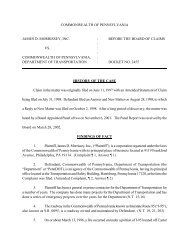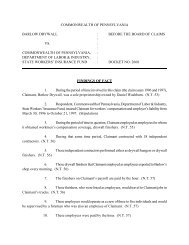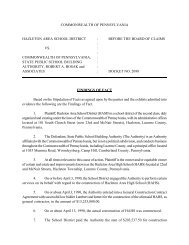3720 - Board of Claims
3720 - Board of Claims
3720 - Board of Claims
Create successful ePaper yourself
Turn your PDF publications into a flip-book with our unique Google optimized e-Paper software.
were unprepared to do so. The Utilities told PennDOT at this June 11, 2001 meeting that they<br />
could not start moving poles as required by the Contract's Construction Sequence.<br />
After some further discussion at this pre-job meeting, the Utilities requested that the order<br />
<strong>of</strong> the Construction Sequence be reversed and that Intercounty start its work in Section Three,<br />
then proceed to Section Two, then Section One. The reason given for this sequence flip was that<br />
there were fewer poles to be moved in Section Three and the change would allow the Utilities a<br />
“better chance” <strong>of</strong> staying ahead <strong>of</strong> Intercounty on the Project. With this change the Utilities<br />
then agreed to begin work on pole relocation in Section Three upon completion <strong>of</strong> the necessary<br />
surveying and staking work by Intercounty.<br />
Prior to this meeting, Intercounty did not know<br />
about PennDOT’s failure to give the Utilities the Construction Sequence.<br />
It was also at this meeting that Intercounty inquired about how utility relocation<br />
arrangements and coordination issues would be handled going forward. PennDOT responded<br />
that coordination with the Utilities would all be handled by "Joe Pilosi and the state." (N.T. 141).<br />
Mr. Nansteel, Intercounty’s construction superintendent, understood from this response that<br />
following the pre-job meeting he was to address any future issues or concerns with utility pole<br />
relocation to Sam Sebastianelli (PennDOT’s lead inspector and primary PennDOT contact<br />
person on the Project day-to-day) and/or Mr. Pilosi. 12<br />
Thereafter, as work proceeded on the<br />
Project and problems with the utility pole relocation escalated, Mr. Nansteel and Intercounty did<br />
as they were instructed and sought PennDOT’s assistance through Mr. Sebastianelli and<br />
12 Mr. Pilosi testified he did not recall telling Mr. Nansteel that all further coordination and contact with the Utilities<br />
would be through him, but he also did not deny saying it. (N.T. 121). Mr. Pilosi's version <strong>of</strong> the conversation is that<br />
Mr. Nansteel asked him if he "was willing to be the contact person for the utilities" and "if [Nansteel] had a problem,<br />
could [Pilosi] contact the utilities and make any suggestions or get any information that they needed and relay that<br />
back to [Sam Sebastianelli, the PennDOT project inspector on the job]" and that he [Pilosi] agreed to this.<br />
Mr. Pilosi also stated that he told Mr. Nansteel that he would "... help out to make the utilities respond quicker and<br />
do anything I could to move this project along." (N.T. 121). The <strong>Board</strong> does not find a direct conflict between the<br />
testimony <strong>of</strong> Mr. Nansteel and Mr. Pilosi, but to the extent their recollections differ, the <strong>Board</strong> found Mr. Nansteel's<br />
version <strong>of</strong> the conversation more credible.<br />
73






